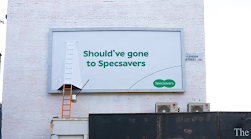Reception Theory
Part 1) Applying Reception theory to adverts
Look back at the adverts you have been analysing in last week's lessons on Reading an Image and media codes (RBK 50 Cent and one of your choice).
1) What are the preferred, negotiated and oppositional readings for the RBK 50 Cent advert?
1) What are the preferred, negotiated and oppositional readings for the RBK 50 Cent advert?
Preferred: Reebok accepts everyone for who they are.
negotiated: Everyone can shop at Reebok.
oppositional: Reebok are siding with gang violence
2) What are the preferred, negotiated and oppositional readings for the advert of your own choice that you analysed for last week's work?
Preferred: Creating a joke can possibly attract more customers
Negotiated: If you don't go Specsavers this is what will happen to you.
Oppositional: Mocking someone who is blind.
Part 2) Reception theory factsheet #218
Use our extremely useful A Level Media Factsheet archive to find Factsheet #218 Spotlight on Stuart Hall: Encoding, Decoding and Reception Theory. Read the factsheet and complete the following tasks and questions:
1) Complete Activity 1 on page 2 of the factsheet. Choose a media text you have enjoyed and apply the sender-message-channel-receiver model to the text. There is an example of how to do this in the factsheet (the freediving YouTube video).
2) What are the definitions of 'encoding' and 'decoding'?
Encoding:
The process of converting files containing digital video and/or audio from one standard format to another.
Decoding:
The way something can be disassembled for their meaning.
3) Why did Stuart Hall criticise the sender-message-channel-receiver model?
He didn’t believe that the ‘message’ had a fixed meaning encoded by the sender to be passively accepted by the
receiver, although he was certain that the senders of the message probably hoped it did.
4) What was Hall's circuit of communication model?
They could work independently of one another in the construction of meaning and the uses audiences make of what they consume would therefore vary.
5) What does the factsheet say about Hall's Reception theory?
which challenged the idea that audiences all understood media texts in a broadly similar way. It’s a way of exploring connections and relationships in the decoding process, the ‘non-linear’ processes between the construction of representations and audience interpretations of them.
6) Look at the final page. How does it suggest Reception theory could be criticised?
Some people have pointed out that Hall’s model assumes that everyone is able to recognise the dominant or hegemonic reading.

great detail
ReplyDeletethanks
Delete